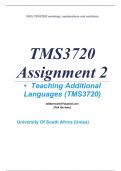100% TRUSTED workings, explanations and solutions
TMS3720
Assignment 2
• Teaching Additional
Languages (TMS3720)
tabbymwesh59@gmail.com
[Pick the date]
University Of South Africa (Unisa)
, Exam (elaborations)
TMS3720 Assignment 2 (COMPLETE ANSWERS) 2024
(159339) - DUE 10 June 2024
Course
Teaching Additional Languages (TMS3720)
Institution
University Of South Africa (Unisa)
Book
English as an Additional Language
TMS3720 Assignment 2 (COMPLETE ANSWERS) 2024 (159339) - DUE 10
June 2024 ;100% TRUSTED workings, explanations and solutions........
QUESTION 1 A multicultural classroom is a melting pot of different cultures,
and it is essential to acknowledge and respect the cultural backgrounds of
each student (Rasool & Curtis 2000:231–232). Teaching an additional
language in a multicultural country requires that a teacher recognises the
diversity of cultures within the classroom. Reciprocal recognition and respect
for one another's cultures and languages are prerequisites for successful
language teaching. With these facts in mind answer the following questions:
1.1 There are two definitions of multiculturalism given by Akcaoğlu, M.O. and
Arsal, Z. 2022. The effect of multicultural education on preservice teachers’ 4
attitude and efficacy: testing Bank’s content integration dimension.
Participatory Educational Research (PER), Vol.9(2), pp. 343-357. Available at:
. Write the two definitions down and, explain in your own words what each
definition says multilingualism is. (10)
Definitions of Multiculturalism
According to Akcaoğlu and Arsal (2022), multiculturalism is defined in two ways:
1. The Coexistence Definition: Multiculturalism involves the coexistence of diverse
cultures, where cultural differences are acknowledged, respected, and valued within a
society.
2. The Educational Approach Definition: It refers to an educational approach aimed at
incorporating the cultural perspectives, texts, values, beliefs, and histories of diverse
cultural groups into the curriculum and educational practices.




